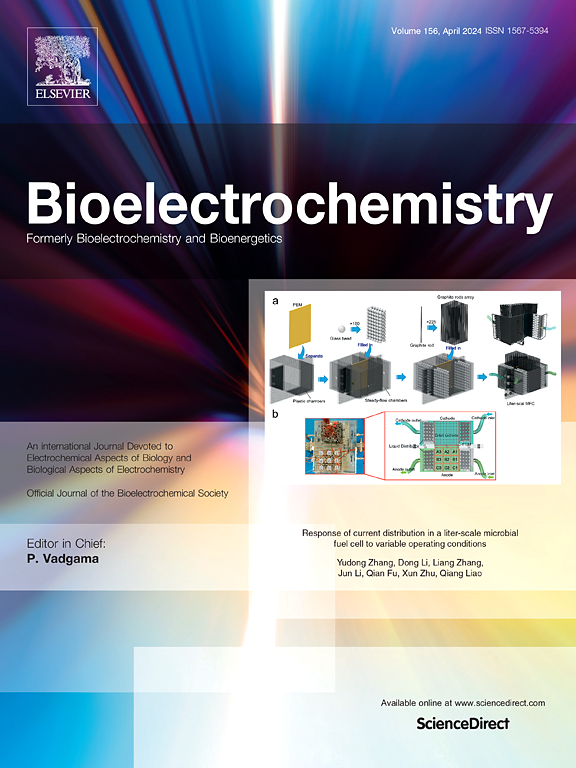电化学还原增强了鲁米诺阴极电化学发光对丙氨酸对映体的痕量手性识别
IF 4.8
2区 化学
Q1 BIOCHEMISTRY & MOLECULAR BIOLOGY
引用次数: 0
摘要
电化学发光(ECL)在手性识别中得到了广泛的应用。基于ecl的手性传感器迫切需要一个灵敏的信号转换和绝对手性识别接口。基于鲁米诺-溶氧体系的ECL排放因其无毒、稳定而受到广泛关注。然而,弱ECL发射的缺点阻碍了信号从手性识别到ECL响应的快速转换。在此基础上,提出了基于电化学还原增强O2还原反应(ORR)的ECL排放放大策略。采用易于合成、宽ph操作和合适价导带位置的硫化镉修饰在碳纳米管(CdS/CNTs)上。阴极扫描时,电子从电化学还原的cds /CNTs转移到O2和H2O2上,从而加速了活性氧(reactive oxide species, ROS)的生成,进一步促进了ECL的释放。此外,将d -氨基酸氧化酶(DAAO)的手性识别与CdS/ cnts增强ECL发射的信号转导和放大相结合,设计了手性ECL传感接口。在daao催化丙氨酸的对映选择性氧化过程中,O2被转化为H2O2,从而调节ROS的产生。由于纳米衍生CdS/CNTs和生物衍生DAAO对ROS生成的协同调节作用,丙氨酸对映体被高度区分,l -丙氨酸以迄今为止最具竞争力的检测限(0.014 fM)被定量检测。本文章由计算机程序翻译,如有差异,请以英文原文为准。

Electrochemical reduction boosted Luminol cathodic electrochemiluminescence for trace chiral recognition of alanine enantiomers
Electrochemiluminescence (ECL) is highly recommended in chiral recognition. ECL-based chiral sensors highly desire a sensitive sensing interface for signal conversion and absolute chiral discrimination. The ECL emission based on a luminol-dissolved O2 system received much attention due to its nontoxicity and stability. However, the drawback of weak ECL emission hinders the fast signal conversion from chiral discrimination to ECL response. Herein, the amplification strategy of ECL emission is proposed based on the electrochemical reduction enhanced O2 reduction reaction (ORR). Cadmium sulfide decorated on carbon-nanotubes (CdS/CNTs) with easy synthesis, wide-pH operation, and suitable valence-conduction band position is employed. Upon cathodic scan, the electrons transfer from electrochemically reduced-CdS/CNTs to O2 and H2O2, thus accelerating the generation of reactive oxide species (ROS) and furthering ECL emission. Furthermore, the chiral ECL sensing interface is well-designed by combining the chiral recognition of D-amino acid oxidase (DAAO) with the signal transduction and amplification of CdS/CNTs-enhanced ECL emission. During DAAO-catalyzed enantioselective-oxidations of alanine, the O2 is converted to H2O2, which tunes the ROS generation. With synergetic regulations of ROS generation by nano-derived CdS/CNTs and bio-derived DAAO, alanine enantiomers are highly discriminated and the L-alanine is quantitatively detected with the most competitive detection limit so far (0.014 fM).
求助全文
通过发布文献求助,成功后即可免费获取论文全文。
去求助
来源期刊

Bioelectrochemistry
生物-电化学
CiteScore
9.10
自引率
6.00%
发文量
238
审稿时长
38 days
期刊介绍:
An International Journal Devoted to Electrochemical Aspects of Biology and Biological Aspects of Electrochemistry
Bioelectrochemistry is an international journal devoted to electrochemical principles in biology and biological aspects of electrochemistry. It publishes experimental and theoretical papers dealing with the electrochemical aspects of:
• Electrified interfaces (electric double layers, adsorption, electron transfer, protein electrochemistry, basic principles of biosensors, biosensor interfaces and bio-nanosensor design and construction.
• Electric and magnetic field effects (field-dependent processes, field interactions with molecules, intramolecular field effects, sensory systems for electric and magnetic fields, molecular and cellular mechanisms)
• Bioenergetics and signal transduction (energy conversion, photosynthetic and visual membranes)
• Biomembranes and model membranes (thermodynamics and mechanics, membrane transport, electroporation, fusion and insertion)
• Electrochemical applications in medicine and biotechnology (drug delivery and gene transfer to cells and tissues, iontophoresis, skin electroporation, injury and repair).
• Organization and use of arrays in-vitro and in-vivo, including as part of feedback control.
• Electrochemical interrogation of biofilms as generated by microorganisms and tissue reaction associated with medical implants.
 求助内容:
求助内容: 应助结果提醒方式:
应助结果提醒方式:


